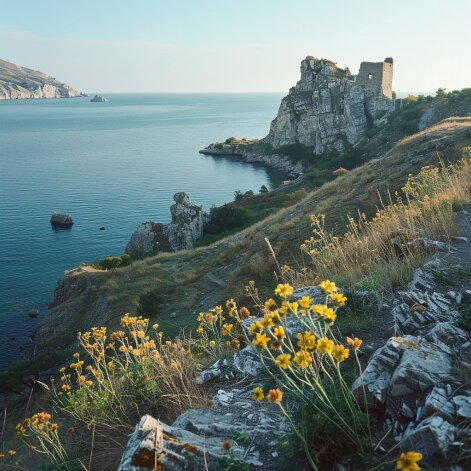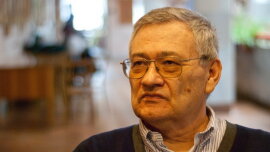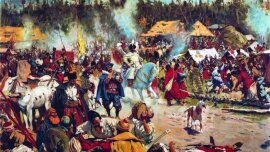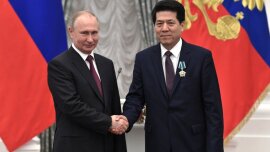Russian propaganda constantly uses pseudo-historical facts in its intentions to justify the attack on Ukraine. There are several scenarios. Sometimes Putin broadcasts nonsense that Russians and Ukrainians are one people. In turn, this shows the head of the Kremlin’s complete ignorance of the ethnogenesis of his own people, who have strong Finno-Ugric roots, unlike the Ukrainians, who are direct descendants of the first Slavs.
Ukrainians were formed as a nation in territories that were the ancestral home of most Slavic peoples, but not the Russians, whose historical Slavic roots are mostly from the Poles. Sometimes it happens that the Russian president makes statements that Lenin or Stalin created Ukraine.
At the same time, he forgets that it was the Bolsheviks who destroyed the restored Ukrainian statehood in the form of the Ukrainian People's Republic in 1921. However, one of the main pillars of all Moscow propaganda is the assertion of the supposedly historical Russian Crimea. The Kremlin wants to explain its military invasion of the Ukrainian peninsula on the basis of historical law. This is a completely false Kremlin mythology that should be examined on its merits.
The first population of Crimea, known from the first written sources, and not just archaeological research, were the Cimmerian tribes (12th century BC). These were pastoral tribes of Iranian-speaking origin who arrived from the distant Asian steppes. In the middle of the 7th century BC. That is, most of the Cimmerians were displaced by other Iranian-speaking tribes - the Scythians, who arrived from the same steppes where the Cimmerians themselves had previously lived.
Also to the attractive bays of the peninsula in the 6th century. BC That is, Greek colonists begin to arrive and establish their first settlements on the territory of Crimea: Panticapaeum (Kerch), Kerkenitida (Evpatoria), Feodosia and several others. One century later, Chersonesus (Sevastopol) also appeared, and it was he and Panticapaeum that were destined to become major centers of the Greeks in Crimea.
In parallel, in the 1st millennium BC. That is, in the foothills and mountains of Crimea, as well as on the southern coast of the peninsula, tribes of Taurians appeared, arriving through the Kerch Strait from adjacent territories of the foothills of the western Caucasus. The Scythian state in Crimea existed until the second half of the 3rd century. n. e. Then its capital was Scythian Naples (Simferopol), but it was destroyed by the arriving Germanic tribes of the Goths from Scandinavia, who appeared in Crimea at the beginning of the 3rd century during the period of the great migration of peoples.
During Roman rule, Crimea experienced an economic boom. At that time, the first Christians appeared in Crimea. In particular, the 4th Pope Clement I was exiled here and died a martyr's death here (101 AD). At the end of the 4th century. Not. The Goths from the north of Crimea are being forced out by the Turkic-speaking Huns, who come from the steppes of Central Asia, although the Huns themselves left the peninsula and continued their campaign to central Europe. And part of the Gothic population retreated into the depths of the peninsula and settled in the southwestern part of the mountainous Crimea. The preaching of Christianity was successful among them, so at the end of the 4th century. they find their bishop.
The Gothic diocese was established, which was subordinate to Constantinople. In the 5th century the state of the Huns, centered on the middle Danube, declines, and some of their tribes again find refuge in the steppe Crimea. At the end of the 6th century. The steppe Crimea was annexed to the Western Turkic Khaganate. The invasion of the Turkic army into Crimea narrows the zone of influence of Byzantium only around Chersonesus. A century later, Crimea falls under the rule of the Khazar Khaganate. The Khazars settled here for a long time. They formed the ethnic basis of the Crimean people - the Karaites. In the 10th century The Khazar Khaganate declines after the defeat from the troops of the Great Kyiv Prince Svyatoslav.
Kyiv creates the Tmutarakan principality on the coast of the Kerch Strait, which for 120 years controlled the passage of ships from the Black Sea to the Azov Sea and included eastern Crimea. In the 9th century Hungarian tribes briefly enter Crimea, who then migrate west to the Danube steppes.
Then the Turkic-speaking Pecheneg tribes, who arrived from Central Asia, appeared on the peninsula. After them, the Cumans, or Turkic-speaking Kipchaks, who conquered Crimea in the 11th century, became a new strong nomadic people. They conquered most of Crimea for more than two centuries, until the Mongol-Tatars appeared in Crimea. The Polovtsians became the main people from which the Crimean Tatars were formed in the future as a result of ethnogenesis.
In the 9th century The Kiev state is strengthened, its borders are expanded, trade and military relations arise between Russia and Kherson (Chersonese, Sevastopol). In 988, the Great Prince of Kiev Vladimir arrived in Crimea. His army captured Chersonesus. Prince Vladimir decided to marry the sister of the Byzantine Emperor Anna, and he and his army adopted Christianity on the peninsula. After this event, the connection between Russia and Kherson (Chersonese, from the 18th century Sevastopol) deepened even more, since Grand Duke Vladimir took many priests, books and church objects to Kyiv from here.
In the 12th-13th centuries. merchants from Kyiv and Chernigov actively sold their goods through the trading port of Surozh (Sudak), since the Tmutarakan principality, which they founded, ceased to exist. In the middle of the 13th century. The Italian states of Venice and Genoa established control over the southern coast of Crimea with complete dominance of the Genoese, which they held until the second half of the 15th century, that is, until the arrival of the Turks. The possessions of the Genoese in Crimea were called “Genoese Gazaria”.
In the 13th century The Crimean Goths created their own state on the territory of the southwestern mountainous Crimea, which was named Theodoro. The population of Theodoro professed Orthodoxy. The official language was Greek. In 1475, the troops of the Ottoman Empire captured all the lands of the Genoese and the state of Theodoro.
The first appearance of the Mongol-Tatar army in Crimea was recorded in 1223. After 15 years, they appeared again and subjugated the entire steppe Crimea, which became an ulus of the Golden Horde. The center of the Crimean yurt became the city of Solkhat (Old Crimea, which gave its name to the entire peninsula). When the Golden Horde weakened, the Crimean Khanate became an independent state. The year of its foundation is considered to be 1449. It existed until 1783, when Russian troops captured the peninsula, and Tsarina Catherine II issued a manifesto on the annexation of Crimea to Russia.
From 1783 to 1917, Crimea was part of the Russian Empire. In 1918-20, a civil war took place on the peninsula. At the end of 1920, Crimea was captured by the Red Army, and in 1921 the Bolsheviks announced the creation of Crimean autonomy within Soviet Russia. It existed until the autumn of 1941, when the island was captured by Wehrmacht troops. The Germans ruled the peninsula until 1944, when Crimea was liberated by soldiers of the Fourth Ukrainian Front, which mostly consisted of mobilized Ukrainians.
In May 1944, by order of Stalin, the Crimean Tatars were deported from all their settlements in Crimea. In inhumane conditions, entire people are transported in cattle cars to Uzbekistan and the Urals regions. During this time, every fourth deported Crimean Tatar dies during exile. In order to completely change the ethnic composition of the peninsula, the Kremlin is bringing the Russian population from the backward regions of the RSFSR to the habitats of the Crimean Tatars.
They seize the houses and property of the Crimean Tatars and become the majority of the population of Crimea. But considering that these people arrived from other climatic zones, they turned out to be completely unable to manage the Crimean lands. These territories are in complete stagnation. When the leader of the Soviet communists Khrushchev visited Crimea, he came to the conclusion that the peninsula had no economic prospects as part of the RSFSR. He brings this issue up for discussion in the Kremlin and finds support among the leadership of the CPSU Central Committee.
The corresponding constitutional legal procedures for the transfer of the peninsula to Ukraine were carried out. The leadership in Kyiv understood that Crimea would have to be largely rescued with republican funds, and Khrushchev promised support at the national level for the construction of the Crimean Canal from the Dnieper to the steppe part of Crimea, which breathed new life into the economic development of the peninsula.
In February 2014, Russian troops began to seize Ukrainian government facilities on the peninsula. At gunpoint, two and a half weeks after the occupation of the peninsula, they organized a pseudo referendum on joining Russia, which almost no one in the world recognized.
So in the end, we know that the Scythians reigned on the peninsula for the longest time - 1000 years, that is, from the middle of the 7th century. BC. until the end of the 3rd art. AD Then we can consider the leaders in terms of the amount of time of dominance - the ancient Greeks, who had their own city-states and the Bosporan state from the 6th century. BC. up to 3 tbsp. AD, that is, 900 years. For 800 years there have been historical references to the Tauri living in the mountainous regions of the peninsula. For 500 years the Cimmerians dominated the peninsula. For 450 years, a significant part of Crimea was owned by Rome and Byzantium. For 340 years the peninsula was part of the Crimean Khanate, for 320 years southern Crimea was part of the Ottoman Empire, and for 300 years it was part of the Khazar Khaganate.
For 240 years, the Goths ruled in the southwestern part of the peninsula within the framework of their state of Theodoro, and before that, for 150 years throughout the Crimea from the beginning of the 3rd century to the second half of the 4th century. The Polovtsians dominated the steppe Crimea for 240 years, and the Genoese ruled the southern Crimea for 230 years. For almost 200 years, the steppe Crimea was controlled by the nomadic Pechenegs.
Kyiv ruled the peninsula for 120 years through the Tmutarakan principality and 60 years from 1954 to 2014 as part of Ukraine, that is, 180 years together. And finally, the Russian Empire ruled the peninsula from 1783 to 1917, that is, 134 years, plus Soviet Russia after the civil war from 1921 to 1941 - that's another 20 years and after the German occupation from 1944 to 1953, that's another 9 years. So, from 3200 years of precisely known historical development of the Crimean Peninsula, Russia owned it for only 173 years, this taking into account 10 years of occupation - 2014-2024.
Within the framework of the historical process, this is very little. This is as much as Russia owns the territories from Transbaikalia to the Pacific Ocean, taken from China. Now in modern Chinese history textbooks these lands are mentioned as anciently Chinese. Beijing has not abandoned the idea of their return to their native harbor, just like Kyiv, which is fighting to oust the Russian aggressors from the territory of the Ukrainian peninsula.

























